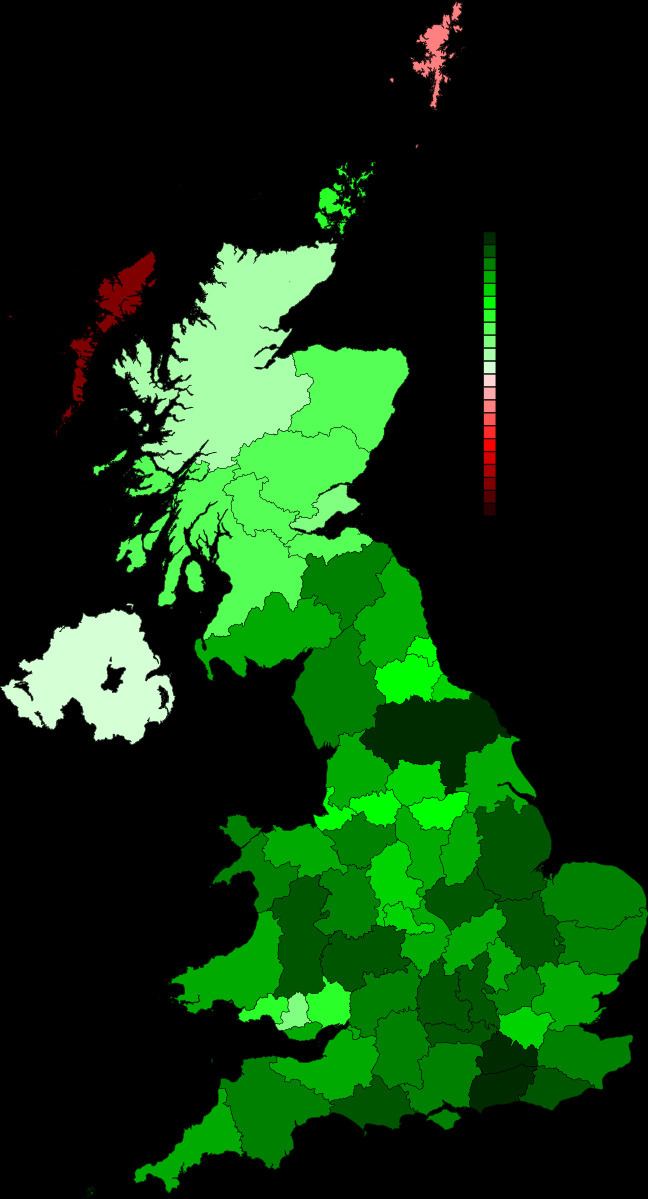Location United Kingdom No 8,470,073 | Yes 17,378,581 | |
 | ||
Date June 5, 1975 (1975-06-05) 17,378,581 7001672300000000000♠67.23% 8,470,073 7001327700000000000♠32.77% | ||
The United Kingdom European Communities membership referendum was a public vote that took place on 5 June 1975, on whether the United Kingdom should remain a member of the European Communities which was principally the European Economic Community (the Common Market) as it was known at the time. At the time the UK had already been a member of the EEC for two and a half years since joining back on January 1, 1973 and was the first ever national referendum of its kind to be held in the country.
Contents
- United Kingdom
- Results by United Kingdom constituent countries
- England
- Wales
- Scotland
- Northern Ireland
- References
This article lists, by voting area, all the results of the referendum, each ordered into national sections.
Under the provisions of the Referendum Act 1975 there was a total of 68 counting areas across the United Kingdom in which counting took place locally. Once the counting areas had officially declared, their results were then relayed by the returning officers to the Chief counting officer Sir Philip Allen who later declared the final result, In England there was a total of 47 counting areas which were made up of the then county council areas of England along with Greater London and the Isles of Scilly. In Wales there was just 8 counting areas which were also made up by the then county council areas. In Scotland the then 12 administrative regions were used as the counting areas with Northern Ireland acting as a single counting area. This meant that of the counting areas the Isles of Silly with 1,447 eligible voters had the smallest electorate and was also the smallest geographically and Greater London with 5,250,343 eligible voters had the largest electorate and Highland in northern Scotland was the largest geographically with 127,925 eligible voters.
This made for a highly centralised national count with local authorities (district councils) in England and Wales verifying votes locally after polls closed but counting of all totals were only permitted to be held and declared at county council or Scottish regional council level apart from the Isles of Silly and was not overseen by any independent public body.
Counting took place on Friday 6 June from 0900 BST, the day after the poll took place and presented unique challenges as large venues were required as there had been no previous experience of counting on such a large and centralised scale and took almost fourteen hours to complete.
United Kingdom
The national result for the United Kingdom was declared just before 2300 BST on Friday 6 June 1975 by the Chief counting officer Sir Phillip Allen at Earls Court Exhibition Centre in London. With a national turnout of 64% the target to secure the majority win for the winning side was 12,951,598 votes. The decision by the electorate was a decisive 'Yes' to continued EC membership which won by a huge majority of 8,908,508 votes (34.5%) over those who had voted 'No' to reject continued membership. The result saw decisive 'Yes' votes from all four countries of the United Kingdom and also saw 'Yes' majority votes from all but two counting areas to continued membership of the European Communities (Common Market) which would later become the European Union.
Results by United Kingdom constituent countries
The data in the below tables is a compilation of information obtained from The Guardian, Butler & Kitzinger's book and a paper published by HM Government,. The latter two sources appear to cite amongst others The Times and the National Counting Office as sources.
England
The order of voting areas below corresponds to that used in Butler/Kitzinger, which is a natural presentation of the voting areas of the United Kingdom. In particular, the votes in England are firstly divided into three areas: the South, the Midlands and the North.
Votes in England were tallied up according to 47 counting areas, 24 in the South, 10 in the Midlands and 13 in the North.
Wales
Wales was broken down into 8 counting areas.
Scotland
Scotland was broken down into 12 counting areas.
Northern Ireland
Northern Ireland was treated as a single counting area.
